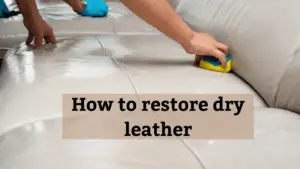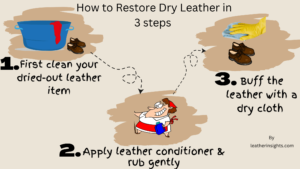How to Restore Dry Leather (in 3 STEPS!)
Leather loses moisture as it ages, especially if it is not well maintained. This makes it prone to stiffening, peeling, and cracking as it continues to weaken over time.
In this article, we will look at how to restore dry leather and the appropriate products you can use.

How to restore dry leather
Dry leather can be restored by conditioning using an appropriate leather conditioner. Conditioning leather replenishes the natural oils and helps in maintaining the leather’s smooth, supple, and flexible properties. Additionally, it adds a layer of protection to the leather’s surface to keep it from drying out.
If you want to repair your dry leather items by making them softer, follow these steps.
Step 1: Clean the leather
To start the restoration process, you need to first clean your dried-out leather products to remove dirt, dust, oil, and grease.
Consider using a gentle cleaner like dove soap or saddle soap to clean the leather. However, if the leather is stained, you should use a quality leather cleaner to get rid of the stains or gently clean the leather using a magic eraser.
To clean the leather, apply the leather cleaner to the surface in circular motions using a soft, lint-free cloth, and then wipe it off with a moist, clean cloth.
Let your leather items air dry before moving to the next step.
Step 2: Apply the leather conditioner
To condition your leather item, you need to first choose an appropriate leather conditioner like Leather Honey.
Avoid silicone and wax-based leather conditioners because they tend to clog the leather pores leaving them clogged and greasy.
Once you have your conditioner, test it on a discrete area of the leather to see if it is safe. If nothing happens, proceed to condition the leather.
Apply a small amount of the conditioner to a soft microfiber cloth and gently rub it on the dried leather. If the leather is very dry and feels stiff, you may need to apply numerous coats at 30-minute intervals until it softens.
Once done, leave your leather item in a cool dry place for about 30 to 60 minutes to give the conditioner time to get deep into the fibers.
Step 3: Buff the leather
The final step to restoring stiff leather is to buff it gently to obtain a shine. Use a soft dry cloth to gently go over the surface of the leather until it shines.
You can also opt to apply leather polish before buffing the leather.

Other ways to treat dry leather
Apart from conditioning, leather can be softened by applying leather oil or beeswax.
-
Softening with leather oil
Oiling leather helps to replenish the leather’s natural oils and aid in reviving its moisture and flexibility.
The type of oil to use depends on the type of leather being oiled. However, natural oils are considered more appropriate since they are gentle.
Consider using natural oils like mink, coconut oil, lanolin, almond oil, and neatsfoot to moisturize the leather. Specialized oils like Obenauf’s leather oil can also be used since they are formulated with natural oils.
When using oil to soften stiff leather, start with a little amount of oil and add more as necessary. Remember to wait a few minutes after applying the oil for it to penetrate deep into the fibers before buffing.
Additionally, it is advisable to test the oil on a discrete section of the leather to see if it is safe before applying it to the whole piece.
-
Moisturize leather with Beeswax
For generations, leather has been conditioned and protected with beeswax, which is a natural product.
The Paul’s Pail Beeswax leather conditioner is an excellent example of all-natural wax. It doesn’t contain any additional chemicals, fragrances, or stains and dyes and functions as a leather conditioner, restorer, softener, and protector against elements.
When applied to dry leather, Beeswax forms a thin coating on the surface that prevents leather from hardening and conditions it.
Additionally, it keeps the leather supple and flexible, making it the perfect solution for treating leather that is dry, damaged, or stiff. It also offers a natural sheen that aids in bringing back the luster of the leather.
To moisturize the leather, melt the Beeswax to make it easy to apply. Then use a clean cloth to apply a small amount of the wax to the surface. After gently rubbing it in, remove any extra wax with a clean cloth.
Repeat this procedure once a month or as necessary for the most remarkable results.
-
Using vinegar to soften dry leather
One household product that can easily relax stiff leather is vinegar.
Since vinegar is acidic, it should be diluted with warm water to make it gentle on the leather.
Prepare a solution of one part vinegar and one part water. You can also add one part of linseed oil or coconut oil to help to condition the leather and to keep it soft.
Dip a lint-free microfiber cloth in the dilute vinegar and rub it gently onto the leather in a circular motion.
Allow the leather to dry for a few hours or leave it overnight. This will make the leather softer and more comfortable to use.
Conclusion
To conclude, leather tends to become dry and stiff if it is not well taken care of.
If you are wondering how to restore dry leather items are dry, you can revive them by applying leather conditioner as instructed in this article.
Oiling will also help to repair the damaged leather. This can be done by using natural oils like olive oil, coconut oil, lanolin oil, mink oil, or neatsfoot oil.
Alternatively, you can prepare a homemade conditioner like a mix of vinegar, linseed oil, and water and use it to clean and condition the dry leather.
Another way to soften leather is by moisturizing it with beeswax which provides a protective barrier on the surface.





